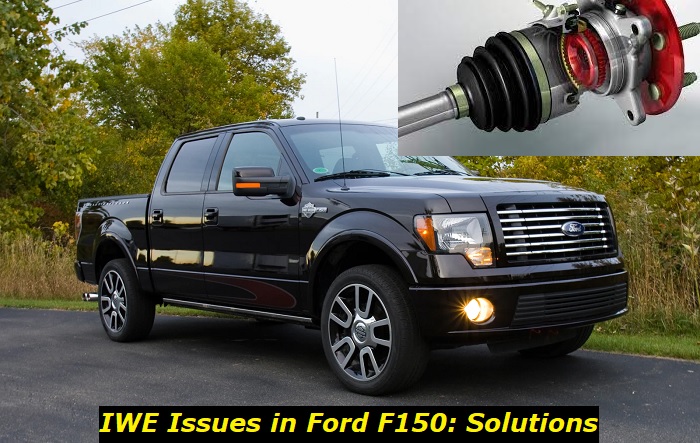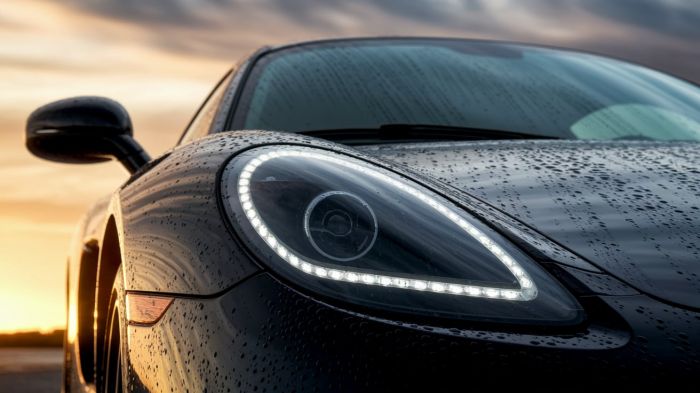The Ford F150 IWE (integrated wheel end) is important for the vehicle to realize its complete potential. It's a system that utilizes a vacuum to lock the hubs when different drive modes are engaged. But this system can develop its own faults just like every other vehicle system.
The F150 IWE noise can sound like "grinding". It's caused by a vacuum leak in the vacuum hoses, vacuum reservoir, or IWE solenoid. Water damage in the IWE solenoid could also be the culprit. Thankfully, some fixes can be made to get rid of the noise.

Our guide will describe the causes of the grinding sound fully and how to diagnose it. There are other related topics to read about in this post such as how the IWE system works, Ford TSB (Technical Service Bulletin) 06-8-15, etc.
IWE System Operation
The Ford F150's integrated wheel end system is crucial to the vehicle's off-roading functionality. This means that you won't be able to use the off-roading feature if the IWE has a fault. This has put several F150 users in difficult situations.
The major parts of the IWE system are the check valve, vacuum solenoid, vacuum reservoir, vacuum hoses, and IWE hubs. There'll be an emphasis on the solenoid's working condition in this article. Think of it as a vacuum switch that regulates the differential lock and ascertains which axles are enabled.
F150s feature the Borg-Warner transfer case that provides 4L, 2H, and 4H. A clutch in the transfer case powers up to link the rear and front output shafts when shifting into one of the 4WD modes.
The system will power up the IWE solenoid routing vacuum to the spring-loaded vacuum-operated hubs situated on the outer CV joint. This is after it hits the desired working rate.
IWE hubs link the front wheel hubs to the front axle shafts or unlink them when the 4WD mode is deactivated. IWE vacuum solenoids get vacuum from the reservoir.
The solenoid obtains a ground path from the powertrain control module (PCM) in 2WD mode. This will open the vacuum valve for the vacuum to be applied to the IWE ends, thereby disengaging the front hubs from the front axle shafts.
Choosing 4WD mode means that the PCM will disconnect ground to the IWE solenoid, stopping the hubs from receiving vacuum. The hubs will be spring-loaded and the internal spring will force the hub to link to the front axle shafts.
Causes of the Grinding Noise
The most common cause of the grinding sound is vacuum solenoid failure. The solenoid is usually positioned on the firewall around where the windshield drain is situated. It malfunctions most times because of water damage.
Vacuum solenoids can sustain damage after it rains or when the car has been in a car wash. For instance, the windshield drain may soak the solenoid or water may leak onto the solenoid due to clogging in the drains. The blockage may be a result of debris, dirt, etc.
Water can also get onto the solenoid in a car wash when it's forced into the drains with high pressure. So you have to be mindful about water entering the unit during the rainy season, winter, or when the car is washed.
A leak in the vacuum line or a leaky IWE hub could be the cause as well. It can create a situation where a vacuum is partially applied to the IWE hubs, leading to them not engaging fully. The hubs will then be neither completely off nor on since there's some vacuum left in the IWE, resulting in the grinding sound.
Thankfully, various diagnoses can be performed to pinpoint the source of the grinding noise. And it can easily be done with the aid of a professional mechanic.
Grinding Noise Diagnoses
Find the IWE solenoid on the passenger side of your F150-under its hood (atop the firewall). Get the manifold vacuum line away from the solenoid and confirm that there's a complete manifold vacuum by utilizing a vacuum gauge.
The engine should be running as you do this. So you'll have to exercise the utmost caution during the process because you're dealing with a running engine.
Seeing a complete manifold vacuum confirms the good working condition of the vacuum line from the manifold to the solenoid. But since there's a reservoir between the solenoid and manifold, the leakdown rate should also be examined while the engine is off.
Close off the engine after leaving the vacuum gauge in place. The gauge should indicate a slow deterioration of the vacuum. Service the vacuum lines, reservoir, or check valve if you see that the vacuum is dropping fast. The check valve is located between the manifold and the solenoid valve.
The next place to assess will be the electrical areas of the IWE system. The solenoid gets power from the light blue/pink cable from the fuse box's fuse 11. This is when the ignition is "on".
There's something you need to do when you see a full battery voltage while the ignition is "on". It's to look out for good ground from the powertrain control module on the red cable when the 2WD mode is activated. Also, look out for a manifold vacuum on the vacuum line that links to the hubs if you notice battery voltage and ground.
Proceed to monitor the working condition of the hubs by utilizing a handheld vacuum pump. Link the pump to the vacuum line that runs from the solenoid to the hubs. Then pump up the vacuum to see if it holds while turning the front wheels.
The vacuum shouldn't drop faster than 1 inch per minute. Investigate a possible vacuum line leak or leaky hub if it drops faster than that rate.
Ford Technical Service Bulletin 06-8-15
The IWE system is a well-engineered system that facilitates smooth driving in all conditions. But it can lead to many hassles when it fails. It's a common issue in the 2004 to 2008 F150s. Thankfully, the problem has been well-documented by Ford for easy diagnosis.
Ford's TSB 06-8-15 is concerned with the issue of water getting into the solenoid, thereby leading to IWE system failure. The water flows from the cowling section and infiltrates the solenoid. This will cause the unit to short out. The 4H light may also not work as a result of the incident.
You can expect codes C1980 and C1879 to be logged into your F150 computer because of the above faults. Read these error codes using a code reader or a sophisticated diagnostic scanner.
Note: Ford Motors Company has upgraded the solenoids to prevent such issues. You can swap out the solenoid with the new model. The new integrated wheel end features an upgraded mounting bracket.
Remove the vacuum lines at the hubs and check for water or traces of moisture. Let any water you see drain out, and then you can utilize compressed air to blow out the lines.
Examine the check valve and reservoir to make sure that they're free of water or moisture. Their present working conditions should also be checked as well.
Swapping Out the F150 IWE Solenoid
You should replace this unit once other potential grinding noise factors have been eliminated. Get an upgraded IWE solenoid part for the swap. The redesigned solenoid valve isn't susceptible to shorting out due to its new water-proofing feature.
Ensure that you get a replacement part that's compatible with your F150 model year. For example, part number 6L3Z-9E441-A.
Changing the solenoid shouldn't be a difficult task since it isn't located in a deep area of the engine. Accessing it is quite straightforward and no special or sophisticated equipment is required. Just get a flathead screwdriver, two sockets (10mm and 8mm), and a socket wrench ready. Follow the solenoid swapping steps below.
Step 1: Unplug the Negative Battery Terminal
Do this before performing the swap, just as you'd do for any replacement of electrical components or repair of electrical faults.
Step 2: Remove the Solenoid
Proceed to use the flathead screwdriver to unclip the solenoid. Then you'll be able to slide the unit down and away from the bracket.
Step 3: Remove the Vacuum Lines and Connector
Pull off these parts, but inspect the lines for signs of moisture or clogging.
Step 4: Install the New Solenoid
You may have to reuse the old solenoid bracket, depending on whether your replacement solenoid comes with a bracket or not. Follow a reverse process of the previous steps to complete the installation.
Conclusion
As stated earlier, you should realize that the whole diagnostic process may be too complex or tedious for you. Your DIY knowledge may just not be enough. And you can't afford to do "trial and error" steps with the diagnoses descriptions in this guide.
Still, repairing the IWE solenoid isn't hard. So it's possible that you'll be able to handle the fix DIY style. Any complex repair or replacement should be left to an expert technician.
About the authors
The CarAraC research team is composed of seasoned auto mechanics and automotive industry professionals, including individuals with advanced degrees and certifications in their field. Our team members boast prestigious credentials, reflecting their extensive knowledge and skills. These qualifications include: IMI: Institute of the Motor Industry, ASE-Certified Master Automobile Technicians; Coventry University, Graduate of MA in Automotive Journalism; Politecnico di Torino, Italy, MS Automotive Engineering; Ss. Cyril and Methodius University in Skopje, Mechanical University in Skopje; TOC Automotive College; DHA Suffa University, Department of Mechanical Engineering






Add comment